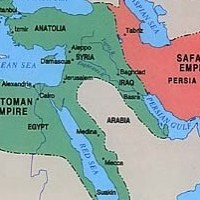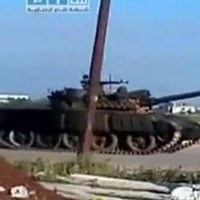![]()
Summer, 2011 | American Interest | By Michael S. Doran and Salman Shaikh
Getting Serious in Syria
Every day there are massive demonstrations, shootings, and defections of soldiers in Syria. Many now think that the dictatorship there is doomed. But what does it all mean, what has happened, and what is likely to happen? For a lot of answers, read “Getting Serious in Syria” by former NSC staffer Michael S. Doran and Salman Shaikh. A readable and brief survey of the issues. — Barry Rubin (via Rubin Reports)
The Arab revolutionary wave of 2011 was slow to arrive in Syria. Public disobedience did not show its face until mid-March, a full month after the fall of Hosni Mubarak. When demonstrations did finally emerge, they focused on the grievances of Daraa, a middling-sized town near Syria’s Yarmuk River border with Jordan. The citizens of Daraa were outraged over state security service atrocities so heinous as to be out of character even for Syria. In early March, a group of 15 boys, aged ten to 15, imitated crowds in Tunisia and Egypt by spraying anti-regime graffiti on the walls of public buildings. Agents of the secret police working for General Atef Najeeb, a cousin of President Bashar al-Assad, detained the boys and tortured them by pulling out their fingernails. Angry citizens of Daraa took to the streets in protest. The regime reacted to the demonstration with lethal force. The Arab Spring had acquired “Syrian characteristics.”
The conflict between Daraa and Damascus soon came to symbolize the grievances of all disaffected Syrians against the regime of President Bashar al-Assad. Across the country, solidarity protests erupted in what soon became a weekly cycle. After Friday prayers, as worshipers flowed out of the mosques, demonstrations would erupt in many different cities at once. The authorities would respond with lethal force, sniping from rooftops and sweeping individual protestors off the streets and into its dungeons. On Saturdays, the funerals of martyrs would generate more protests and more killings by the authorities.
At the end of April, the regime attempted to break this cycle and reestablish its deterrent capability with a show of gruesome force. It laid siege to Daraa, cutting off electricity and water, conducting house-to-house searches and shooting anything that moved on the streets. It was during the siege that security forces tortured, murdered and partially dismembered a 13-year old boy named Hamza Ali al-Khateeb, who almost instantaneously became a global media martyr. The city suffered greatly but did not back down. Nor was the rest of the country cowed. Protests continued unabated.
The contrast with Egypt was striking. In Cairo, protesters quickly paralyzed public life, and the military, for its part, refrained from firing on civilians. In a matter of days, foreign and domestic pressure forced President Mubarak to step down. In Syria, however, Assad managed to keep the biggest cities, Damascus and Aleppo, relatively calm by resorting to the selective killing of civilians in cold blood, some targeted but some seemingly random. Be that as it may, several provinces slowly slipped out of tight control. Hama, the fourth-largest city in the country, and Homs, the third-largest, displayed an unprecedented autonomy from Damascus.
By mid-July, at least 1,400 people had been killed and more than 10,000 were missing. These numbers are bound to grow. Though still in power, Bashar al-Assad had proven incapable of vanquishing the protestors — not, evidently, because he has been less ruthless than his father, but because Syrian society itself has changed. His regime is now locked into a grindingly slow process of irreversible decline.
A Most Peculiar Regime
What accounts for the “slow-motion” quality of the collapse of Assad’s rule? The answer begins with the fundamental character of the regime. During its four-decade life, outbreaks of domestic unrest have been few and far between. Prior to the Assad era, however, instability was the norm. From independence in 1945 until November 1970, when Bashar’s father Hafiz took power, Syria was a state plagued by chronic political unrest. In just one year, 1949, the country witnessed three separate military coups within an eight-month period. Egypt, by comparison, was tranquil. This difference arises from the fact that in Egypt the state and the society fit together comfortably as a cohesive unit. The Syrian state is not only young in historical terms (having been created in the aftermath of World War I), but it also sits atop a heterogeneous society characterized by deep horizontal fissures.
The rise of the House of Assad undeniably brought stability to Syria. However, this achievement, if that is the appropriate term, came at a high price. Nothing better exemplifies that price than the events of 1982, when the regime brutally confronted a Muslim Brotherhood-led insurgency centered on the city of Hama. In a successful bid to suppress the revolt, Hafiz al-Assad perpetrated one of the worst atrocities in modern Arab history. The military laid siege to the city and unleashed an artillery barrage that leveled an entire civilian quarter. The death toll is unknown, but estimates range from 10,000 to 40,000. Contemporaneous accounts describe the stench of rotting corpses wafting out of the rubble.
The Hama massacre highlights the most salient feature of Syrian political life: the mailed fist of the state. Prior to the March 2003 invasion of Iraq, Saddam Hussein was universally regarded as the most brutal dictator in the Arab world. He was that, but Hafiz al-Assad ran a close second — the difference between them reputedly being that while Saddam actually enjoyed torturing and murdering people, the elder Assad did similar deeds out of perceived necessity, without excess or flamboyance. Bashar al-Assad has continued his father’s approach, adding a veneer of forced geniality to what is otherwise the same basic deal. It is impossible to explain the longevity and stability of the Assad era without reference to the totality of the regime’s police state and its ability to smother all forms of independent political activity through continued use of violent repression.
However, as is the case in any successful police state, violence must be rationalized and routinized if it is to bring stability to a deeply divided society. In Syria, the Ba‘ath Party provides this service. The Syrian political system, a single-party state, is something of an anachronism, a throwback to the heyday of the Cold War. The Ba‘ath, like the East European communist parties of yesteryear, is the sole legitimate political organization in the country.
On paper, the Ba‘ath is the vanguard of a populist pan-Arab movement, and, to be sure, Ba‘athi values are not entirely irrelevant to the regime’s behavior. An extreme nationalism that stresses the unity of all Arabs and hostility to American imperialism and Zionism does have its true believers as well as its practical uses. It is the latter, however, that are trump. Ba‘athi rhetoric serves, for example, to deflect attention from the fact that the ruling family and most of its closest associates are members of the Alawi religious community, which constitutes only 10–12 percent of the population. Historically, the community was despised by the Sunni Arab majority, which outnumbers it by a factor of at least five to one. The regime is perpetually vulnerable to the claim that it is a tool used by an unrepresentative “Shi‘a minority” to dominate Sunnis. Ba‘athi ideology allows the Assad family to disprove such claims by arguing that it is the staunchest representative of common “Arab” values and a fierce opponent of the recognized enemies of all Arabs.
Michael S. Doran is senior fellow at the Saban Center for Middle East Policy of the Brookings Institution. Salman Shaikh is director of the Brookings Doha Center and fellow at the Saban Center for Middle East Policy. A version of this essay will appear as a chapter in the forthcoming book from the Saban Center at Brookings, The Great Arab Awakening: America and the Transformation of the Middle East (Brookings Press, 2011).



 RSS
RSS











Getting Serious in #Syria | #Assad http://bit.ly/n1eYRN
Getting Serious in Syria | Middle East news, articles, opinion and analysis | CrethiPlethi.com http://fb.me/12S3xHiQ7
Getting Serious in Syria | Middle East news, articles, opinion and analysis | CrethiPlethi.com http://fb.me/12S3xHiQ7
Getting Serious in #Syria | #Assad http://bit.ly/n1eYRN